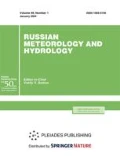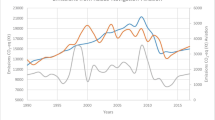Abstract
Data on anthropogenic emissions from industrial sources and motor vehicles to the atmosphere over the Moscow region over the past decade (2009–2018) are analyzed. The spatial distribution of emissions, its links to the distribution of urban areas and to the transport network location within the study region are considered. The estimates of trends in anthropogenic load of air pollutants as well as their atmospheric concentrations in the region are presented.



Similar content being viewed by others
REFERENCES
E. Yu. Bezuglaya and I. V. Smirnova, City Air and Its Changes (Asterion, St. Petersburg, 2008) [in Russian].
Bulletin of Environmental Pollution in the Moscow Region in 2018 (Roshydromet, Moscow, 2019) [in Russian].
The Dynamics of Industrial Production: Advanced Growth of the Mining Sector. Bulletin on Current Trends in the Russian Economy, No. 51 (2019), https://ac.gov.ru/files/publication/a/23445.pdf (Accessed on February 11, 2020) [in Russian].
I. N. Kuznetsova, I. Yu. Shalygina, M. I. Nakhaev, A. A. Glazkova, P. V. Zakharova, E. A. Lezina, and A. M. Zvyagintsev, “Adverse Meteorological Factors for Air Quality,” Trudy Gidromettsentra Rossii, No. 351 (2014) [in Russian].
Adverse Meteorological Conditions. Open Data Portal of the Government of Moscow, https://data.mos.ru/opendata/7704221753-neblagopriyatnye-meteorologicheskie-usloviya (Accessed on February 13, 2020) [in Russian].
Provision with Personal Passenger Vehicles for the Subjects of the Russian Federation (Rosstat, 2019), http://www.gks.ru/free_doc/new_site/business/trans-sv/t3-4.xls (Accessed on February 4, 2020) [in Russian].
Main Indicators of Environmental Protection: Statistical Bulletin (Rosstat, 2019), https://gks.ru/storage/mediabank/oxr_bul(7).rar [in Russian].
Resolution of the Government of Moscow Dated September 14, 2011 No. 429-PP “On Approval of the State Program of Moscow “Energy Saving in Moscow for 2011, 2012–2016, and for the Future till 2020” [in Russian].
Length of Public Motor Roads for the Subjects of the Russian Federation in 2018 (Rosstat, 2019), http://www.gks.ru/free_doc/new_site/business/trans-sv/t2-2.xls (Accessed on February 10, 2020) [in Russian].
The Regions of Russia. The Main Characteristics of the Subjects of the Russian Federation in 2019: Statistical Collection (Rosstat, Moscow, 2019) [in Russian].
The Strategy of Socioeconomic Development of the Moscow Oblast for the Period till 2030. Approved by the Resolution of the Government of Moscow Oblast Dated December 28, 2018 No. 1023/45 [in Russian].
Ecological and Climatic Characteristics of the Atmosphere in 2013 According to the MSU Meteorological Observatory Data, Ed. by N. E. Chubarova (MAKS Press, Moscow, 2014) [in Russian].
J. G. Acker and G. Leptoukh, “Online Analysis Enhances Use of NASA Earth Science Data,” Eos, Trans. AGU, No. 2, 88 (2007).
I. B. Konovalov, M. Beekmann, A. Richter, J. P. Burrows, and A. Hilboll, “Multi-annual Changes of NOx Emissions in Megacity Regions: Nonlinear Trend Analysis of Satellite Measurement Based Estimates,” Atmos. Chem. Phys., 10 (2010).
F. Lespinas, Y. Wang, G. Broquet, F. M. Breon M., Buchwitz, M. Reuter, Y. Meijer, A. Loescher, and P. Ciais, “The Potential of a Constellation of LEO Satellite Imagers to Monitor Worldwide Fossil Fuel CO2 Emissions from Large Cities and Point Sources,” inIG3IS/TRANSCOM Workshop “Inverse Modelling of Greenhouse Gas Fluxes from Atmosphere Observations,” Lund, 17–20 September 2018.
Funding
The research was partly performed in the framework of the Research and Development theme AААА-А20-120013190049-4 “Development of Methods and Technologies for Monitoring Environmental Pollution due to Transboundary Transport of Pollutants (UNECE: EMEP, ICP IM) and Acid Fallouts in East Asia (EANET)” (Roshydromet Research and Development Plan for 2020, vol. 4.4). Satellite data were processed in the framework of the research theme according to the Plan of Fundamental Scientific Research of National Academies of Sciences No. 0148-2019-0009, АААА-А19-119022190173-2 “Climate Change and Its Consequences for the Environment and Population Life on the Territory of Russia.”
Author information
Authors and Affiliations
Corresponding author
Additional information
Russian Text ©The Author(s), 2020, published in Meteorologiya i Gidrologiya, 2020, No. 8, pp. 58-66.
About this article
Cite this article
Gromov, S.A., Zhadanovskaya, E.A., Trifonova-Yakovleva, A.M. et al. Anthropogenic Load on Air in the Moscow Region due to Emissions from Stationary and Mobile Sources . Russ. Meteorol. Hydrol. 45, 553–558 (2020). https://doi.org/10.3103/S1068373920080051
Received:
Revised:
Accepted:
Published:
Issue Date:
DOI: https://doi.org/10.3103/S1068373920080051




